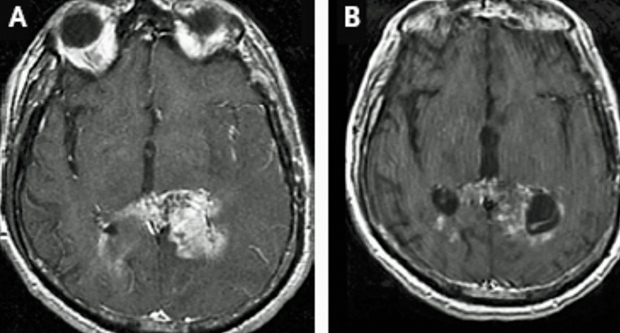Old Drugs Find New Target For Treating Brain Tumor
By:
- Scott LaFee
Published Date
By:
- Scott LaFee
Share This:
Article Content

An MRI depicts a glioblastoma (center white mass) before treatment with the drug erlotinib (A) and after (B).
Scientists at the University of California, San Diego School of Medicine and UC San Diego Moores Cancer Center, in collaboration with colleagues in Boston and South Korea, say they have identified a novel gene mutation that causes at least one form of glioblastoma (GBM), the most common type of malignant brain tumor.
The findings are reported in the online edition of the journal Cancer Research.
Perhaps more importantly, the researchers found that two drugs already being used to treat other forms of cancer effectively prolonged the survival of mice modeling this particular form of GBM. That could be good news for at least some GBM patients. More than 9,000 new cases of the disease are diagnosed each year in the United States and effective treatments are limited. The tumors are aggressive and resistant to current therapies, such as surgery, radiation and chemotherapy. The median survival rate for newly diagnosed GBM patients is just 14 months.
Past studies have identified epidermal growth factor receptor (EGFR) as a common genetically altered gene in GBM, though the cause or causes of the alteration is not known. The research team, led by scientists at the Dana-Farber Cancer Institute in Boston, analyzed the GBM genomic database, ultimately identifying and characterizing an exon 27 deletion mutation within the EGFR carboxyl-terminus domain (CTD). An exon is a segment of a DNA or RNA molecule containing information coding for a protein or peptide sequence.
“The deletion mutant seems to possess a novel mechanism for inducing cellular transformation,” said Frank Furnari, PhD, associate professor of medicine at the UC San Diego School of Medicine and an associate investigator at the San Diego branch of the Ludwig Institute for Cancer Research.
The study researchers determined that cellular transformation was induced by the previously unknown EGFR CTD deletion mutant, both in vitro and in vivo, and resulted in GBM in the animals. The researchers then turned to testing a pair of approved drugs that target EGFR: a monoclonal antibody called cetuximab and a small molecule inhibitor called erlotinib.
Cetuximab, marketed under the name Erbitux, is currently approved for use in treating metastatic colorectal cancer and squamous cell carcinoma of the head and neck. Erlotinib, marketed under the name Tarceva, is used to treat lung and pancreatic cancers.
Both drugs were found to effectively impair the tumor-forming abilities of oncogenic EGFR CTD deletion mutants. Cetuximab, in particular, prolonged survival of mice with the deletion mutants when compared to untreated control mice.
However, neither cetuximab nor erlotinib is an unabashed success story. The drugs work by binding to sites on the EGFR protein and inhibiting activation, but they are not effective in all cancer patients and produce some adverse side effects, such as rashes and diarrhea.
But Santosh Kesari, MD, PhD, Director of Neuro-Oncology at UC San Diego Moores Cancer Center and the UCSD Department of Neurosciences, and co-corresponding author of the study, said the new study points to a more selective, effective use of the drugs for some patients with GBM.
“In the past when we treated brain cancer patients with these drugs, the response rate was very small,” Kesari said. “What we now show is that the tumors with CTD mutations respond best to these EGFR targeted agents. If we knew this beforehand, we might have been able to select patients most likely to respond to these agents. We are now trying to put together a prospective clinical trial to prove this. We would select only patients with these tumor mutations and treat them. This kind of research gets us closer to identifying genetic subtypes, to doing better biomarker-based clinical trials, and to personalizing treatments in brain cancers.”
“This is a great example of personalized medicine in action,” said Webster Cavenee, PhD, director of the Ludwig Institute at UC San Diego. “UCSD has made a concerted effort in the past few years to develop a first-class brain tumor research and therapy group that includes adult neuro-oncology, neurosurgery, neuropathology and their pediatric equivalents to join with internationally-renowned brain tumor research. This is making UCSD a destination for the very best in brain tumor management.”
Co-authors of the study are Jeonghee Cho, Department of Medical Oncology, Dana-Farber Cancer Institute, Center for Cancer Genome Discovery, Boston, MA, Genomic Analysis Center, Samsung Cancer Research Institute, Seoul, Republic of Korea; Sandra Pastorino and Ying S. Chao, Department of Neurosciences, Moores Cancer Center, UC San Diego; Qing Zeng and Xiaoyin Xu, Department of Radiology, Brigham and Women’s Hospital, Boston; William Johnson, Dana-Farber Cancer Institute, Center for Cancer Genome Discovery, Boston; Scott Vandenberg, Department of Pathology, UC San Diego; Roel Verhaak, Amit Dutt, Derek Chiang and Yuki Yuza, Department of Medical Oncology, Dana-Farber Cancer Institute and Broad Institute of MIT and Harvard; Andrew Cherniack and Robert C. Onofrio, Broad Institute of MIT and Harvard; Hideo Watanabe and Matthew Meyerson, Department of Medical Oncology, Dana-Farber Cancer Institute, Center for Cancer Genome Discovery and Broad Institute of MIT and Harvard; Jihyun Kwon, Genomic Analysis Center, Samsung Cancer Research Institute.
Funding for this research came, in part, from the National Institutes of Health, the Sontag Foundation Distinguished Scientist Award, James S. McDonnell and the Samsung Cancer Research Institution.
Share This:
Stay in the Know
Keep up with all the latest from UC San Diego. Subscribe to the newsletter today.



